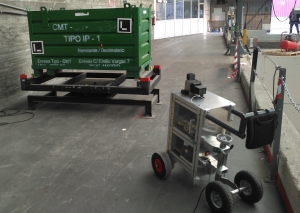IFIC develops a system to improve the dismantling of nuclear power plants
Researchers of the Institute of Corpuscular Physics (IFIC), a joint centre of the University of Valencia and the CSIC, has developed a system that helps classify the waste generated in the dismantling of nuclear power plants. GUALI, as it is called, will reduce costs and storage volume. The system has been developed together with the public company ENRESA and has been successfully tested in the dismantling of the Zorita plant.
The management of radioactive waste is an important issue from an environmental and economic point of view. The next decade is facing the closure of many nuclear power plants around the world, including the seven that still work in Spain. The cost of dismantling in our country is estimated at 4,000 million, to which the costs of managing radioactive waste are added. Thus, a correct and efficient classification of these wastes is vital, since the space to store them is very limited.
The GUALI (Gamma Unit Advanced Location Imager) system consists of a portable device that detects gamma radiation from radioactive isotopes and determines its distribution by spectrometry. By combining this data with a front camera to determine spatial coordinates, GUALI allows you to locate the most active areas within the containers where the waste generated in the dismantling of the plant is stored.
In nuclear waste management, volume matters. Of the 100,000 tons generated in the dismantling of the José Cabrera (Zorita) plant, 9,000 were classified as radioactive waste. These are classified according to their activity: those of discharge, which include elements with periods of disintegration exceeding 30 years, are located on land of the plant itself, waiting to resolve the location of the Centralized Temporary Warehouse (ATC). Those of medium and low activity – the vast majority – are stored in ENRESA’s facilities in El Cabril (Córdoba), which are almost 80% of their capacity.
“That is why it is so important to know in detail how radioisotopes are distributed in containers and to make them as homogeneous as possible”, explains Luis Caballero Ontanaya, one of the IFIC researchers in the project. Caballero has experience in the field of medical physics and nuclear medicine, where gamma cameras are used for cancer diagnosis. The application of this technique to the management of nuclear waste arose from a meeting between research staff and companies organised by the CPAN Consolider Network in 2014. The project was developed through a contract between ENRESA and the CSIC, and has resulted in two patents.
“We have designed a portable device, which will allow its use in the different areas of the nuclear power plant during the dismantling process, and for autonomous use by the ENRESA team through data analysis software”, summarises Caballero. The first GUALI prototype has been tested in the dismantling of the José Cabrera plant, the first to operate in Spain (1968) and the first where the process is carried out completely (approximately 10 years, 2010-2020).
The next GUALI phase will include the development of new spatial reconstruction techniques based on artificial intelligence and improvements to perform measurements directly at the different facilities of the nuclear power plant in the previous phase of characterisation of radioactive materials. These improvements will be tested in the dismantling of Santa María de Garoña (Burgos). The calendar for the closure of nuclear power plants in Spain provides for the phased cessation, of the seven that still work, during the 2027-2035 period.




















